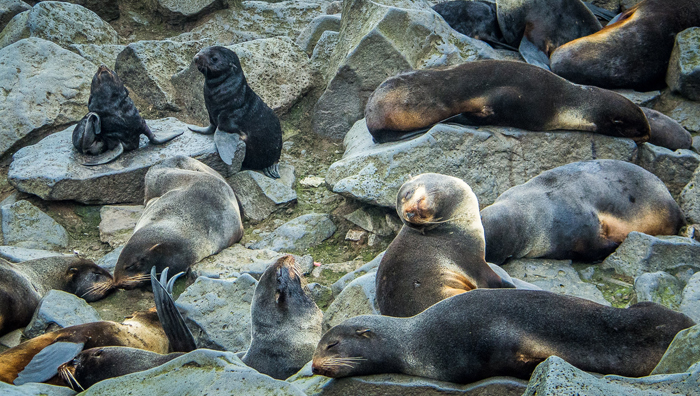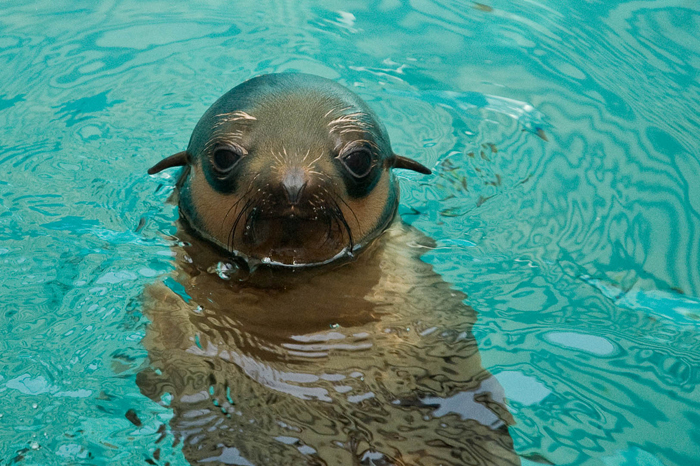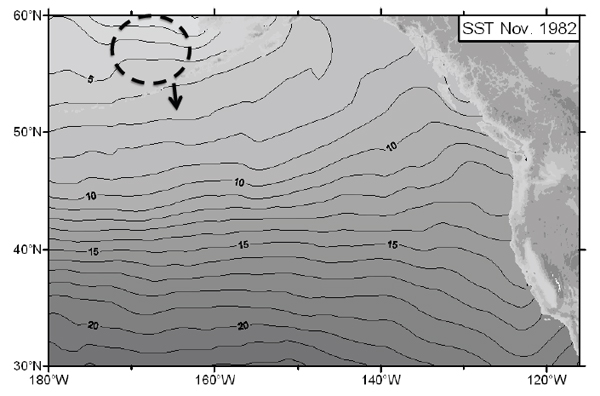
image caption: Two northern fur seal pups amongst sleeping adult females on the Pribilof Islands.
Are young northern fur seals vulnerable to changes in ocean temperature?
Each fall, thousands of northern fur seals leave their summer island homes and take to the chilly waters of the Bering Sea to begin their annual winter migration. Most will follow a route that takes them into the North Pacific Ocean, with some traveling as far south as California, through a wide range of ocean temperatures.
For the most vulnerable members of this migration—the four-month-old pups beginning their life at sea—survival will depend on their ability to conserve energy, stay warm, and catch enough fish to keep them going until they return to their natal rookeries almost two years later. Two new Consortium studies, recently published in Marine Mammal Science, investigated the ability of young fur seals to regulate their internal temperature across a range of ocean temperatures.
“Northern fur seals are small, naïve animals that look like they should not be able to survive in the Bering Sea, except that they have these incredibly thick fur coats,” says Dr. David Rosen, a co-investigator in both studies. “Our main question was whether cooler water temperatures might cause young and vulnerable fur seals to require more energy to stay warm. We also wanted to know whether water temperatures might determine where they are found in the ocean.”
Thermal Neutral Zone
The two studies progressively followed six female northern fur seals, raised at the Vancouver Aquarium, through their first four years of life. Using a range of temperatures that northern fur seals might naturally encounter in the wild, the scientists sought to establish a “thermal neutral zone” (TNZ) for younger northern fur seals—the range of temperatures within which they do not need to expend any additional metabolic energy to stay warm or cool down. The TNZ varies across marine mammal species and has not been well studied in fur seals.

Meechi, one of the young fur seals that participated in the study at the Vancouver Aquarium
“The northern fur seal pups seemed to have a broad TNZ,” says Alex Dalton, lead author of one of the studies, and who recently completed a Master’s of Zoology under Dr. Rosen and Dr. Andrew Trites. “For the most part, the older pups were thermally neutral within water temperatures of 2-18 degrees Celsius throughout the year. This means that the range of water temperatures they would encounter throughout their migration is probably not placing any additional energetic demands on them.”
Dalton emphasizes that these studies are different from past TNZ research on northern fur seals, because they took place over four years, which allowed the scientists to gather data across all seasons and look for differences as the pups grew. “In the first two years of life, our study suggests that the fur seals would have to expend additional energy to keep warm in water below approximately 4-7 degrees Celsius”, notes Dr. Rosen. “However, our follow-up study of the fur seals when they were a few years older shows an increased ability to withstand much colder water temperatures.”
Driving Migration
Rosen believes that several factors seem to trigger the fur seals’ annual migration, including storms and cooler air temperatures. He believes cooler sea surface temperatures may also play a role.
“Most younger fur seals probably could not survive winter in the Bering Sea,” Rosen explains. “The cooler surface temperatures may help to initiate the migration but they did not seem to be a driving factor in determining the route. In other words, the lower thermal limit did not match the migration pattern, which suggests they are migrating well within their thermal neutral zone and not just trying to stay ahead of the cold water.”

Monthly average sea surface temperatures recorded in November between the Bering Sea (2 °C at top of map) and Hawaii (22 °C – bottom of map). Most fur seal pups are in the Bering Sea in November (dashed circle) and migrate into the warmer waters of the North Pacific Ocean as winter approaches.
If thermoregulation is not driving the migration route, except under extreme environments, Rosen believes the probable motivation is food sources.
“This relates back to a key question of whether a decrease in the availability of prey is adding to the decline in northern fur seal populations in the Bering Sea, as opposed to changes in ocean climate or more frequent winter storms,” Rosen says. He is also the lead author in a follow-up study recently published in Conservation Physiology, which found that nutritionally stressed young northern fur seals are better able to regulate their temperature in winter than in summer.
Dalton is interested in following up his study by investigating the reasons for the differences between thermoregulation abilities of northern fur seals versus sea otters, which are equally well known for their thick fur coats but significantly higher energetic requirements.
 PUBLICATIONS
PUBLICATIONS
|

|

 |
||||||||||||
|

|

 |
||||||||||||
|

|

 |
||||||||||||
